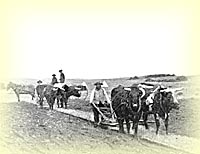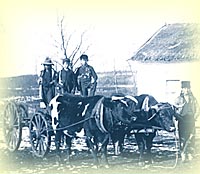|
The Transition to Cattle Ranching
European fur traders, administrators, missionaries and early settlers brought cattle to the West, using oxen to pull their wagons and keeping cows for milk and meat. Métis and Native families soon began breeding oxen to pull their carts. Native people living near the fur trading posts on the Plateau herded and pastured the company's cattle, and gained the skills and knowledge needed to establish their own ranches. As the buffalo herds disappeared and starvation began to take a toll on the Native population, the governments of Canada and the United States brought cattle onto the reserves. Native people on the Plains and Plateau started new lives as ranchers and cowboys.
During this period, several communities began using cattle and deer, instead of buffalo, for certain ceremonial purposes. Cow hides were used for offerings or to wrap sacred bundles. Cow tongue was served at a number of ceremonies, including the Sundance. In some instances, painted cow robes replaced the elaborately painted buffalo robes.
Introduction | Hunting Methods | Products of Life | Buffalo and Deer Imagery | Buffalo Ritual | Decimation of the Buffalo and Deer | Re-emergence of the Buffalo | Transition to Cattle ranching Introduction | Buffalo and Deer | Dog and Coyote | Honouring the Horse SACRED BEINGS | RANCHING | ENTERTAINMENT | RODEO | ARTS AND INDUSTRIES |




